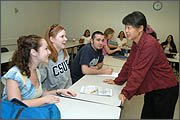| 
Business Students Learn
Art of Negotiation
In Labor Management Simulation
by Pamela McLaren
from Dateline (April 24, 2003)
 |
Mei L. Bickner, professor of
management, right, discusses a point with students from her
upper-division labor management relations course. Last week,
the students received instructions and are now preparing
for a bargaining simulation that will be held May 10. Pictured
are, from left, Kimberly Block, Sarah Holmgren and Brian Orriny.
|
Students in two Cal State Fullerton management
courses have put aside their textbooks and rolled up their sleeves
as they conduct research, network with team members and working
professionals, and analyze information.
On May 10, 70 students from the labor management relations
course will put their preparation “on the table” when
they face off as either labor or management in a bargaining simulation.
The student teams will attempt to negotiate agreements
involving health insurance and other benefits, profit sharing, salaries
and overtime. Like the real world, they will struggle with plant
closings, outsourcing of jobs and whether the company is making
or losing money.
“To really learn negotiating, lectures and talking
about it only goes so far,” says Mei L. Bickner, professor
of management and a labor and employment arbitrator since 1980.
“That’s why I offer this simulation. There is no better
way for students to get a real feel for what it takes to negotiate
agreements.”
During a period of three weeks, the students will
pour over the simulation Bickner has provided. They will analyze
strengths, advantages and weaknesses of the employer and the union,
as well as the merits and limitations of the expiring collective
bargaining agreement. Having received the simulation last week,
they are in the midst of choosing issues ranging from salaries,
pensions and sick leave to seniority, management rights and grievance/arbitration
procedures.
The students also are consulting with federal mediators,
employee relations directors and representatives of several unions
who have volunteered to help out by providing advice on substance
and strategy.
“They are my volunteer coaches,” Bickner
says with a smile, adding that those helping out are former students
and contacts that she has made over the years. “It’s
good for the students to not only work together but to network with
these professionals.”
Among those resource professionals is Kim Cano (B.A.
business administration-management ’01), an employee/union
relations consultant with Boeing Satellite Systems Inc. who took
Bickner’s class and was hired by Boeing with Bickner’s
recommendation. “I remember when I was in the class, we just
wanted to settle,” she says. “But when you invest in
the process, you really start to believe in what you're fighting
for.”
Cano notes that in addition to all the preparation
and the simulation, another important part of the process is the
cool down, when the students reflect and talk about the strategies
they used.
“This is really an excellent process,”
says Andy Shelby, manager of human resources operations at Boeing
Satellite Systems in Los Angeles and another of the working professionals
assisting with the classes. “The preparation, the negotiations
and outcomes – all are fairly close to the real process.
“The students are very bright and really do
their homework,” Shelby adds. “The more preparation
they do, the better they are at negotiations. They really learn
a lot.”
Raymond G. Huffer, division chair of the Transportation
Communications International Union, Lodge 1315 in Anaheim, agrees.
“You see the same personalities and techniques that you would
see in real negotiations. I enjoy seeing the students go through
the simulation – their seriousness.”
“It’s a tough class,” says Bickner. “There
is lots of preparation and no shortcuts. They meet across the tables
and have to use all their skills, book learning and gut feelings
to work out an agreement.”
On May 10, the students face their counterparts and
begin the negotiations under the eyes of observers. After five hours
the teams must come to either an agreement or hit an impasse.
“If they reach an impasse, they have to write
a 75-page paper to ensure that they understand the costs of not
reaching an agreement,” adds the professor, who has provided
arbitration training for the American Arbitration Association and
negotiation simulations at a number of conferences.
At the end of the simulation, the student teams prepare
a folder outlining the preparation that they went through –
analysis, negotiation priorities, the proposals that they exchange
a week before the actual negotiation, a follow-up audit and minutes
from team meetings.
“They complain the whole time about the amount
of preparation they need to do but they feel good when they have
accomplished the task,” says Bickner. “These students
will never forget this class or the lessons they receive.”
| Media Contacts: |
Mei L. Bickner, professor of management, at 657-278-3828 or mbickner@fullerton.edu
Pamela McLaren of Public Affairs, at 657-278-4852 or
pmclaren@fullerton.edu |
« back to University News
|